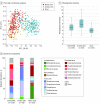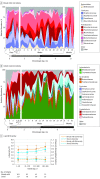Association Between Breast Milk Bacterial Communities and Establishment and Development of the Infant Gut Microbiome
- PMID: 28492938
- PMCID: PMC5710346
- DOI: 10.1001/jamapediatrics.2017.0378
Association Between Breast Milk Bacterial Communities and Establishment and Development of the Infant Gut Microbiome
Abstract
Importance: Establishment of the infant microbiome has lifelong implications on health and immunity. Gut microbiota of breastfed compared with nonbreastfed individuals differ during infancy as well as into adulthood. Breast milk contains a diverse population of bacteria, but little is known about the vertical transfer of bacteria from mother to infant by breastfeeding.
Objective: To determine the association between the maternal breast milk and areolar skin and infant gut bacterial communities.
Design, setting, and participants: In a prospective, longitudinal study, bacterial composition was identified with sequencing of the 16S ribosomal RNA gene in breast milk, areolar skin, and infant stool samples of 107 healthy mother-infant pairs. The study was conducted in Los Angeles, California, and St Petersburg, Florida, between January 1, 2010, and February 28, 2015.
Exposures: Amount and duration of daily breastfeeding and timing of solid food introduction.
Main outcomes and measures: Bacterial composition in maternal breast milk, areolar skin, and infant stool by sequencing of the 16S ribosomal RNA gene.
Results: In the 107 healthy mother and infant pairs (median age at the time of specimen collection, 40 days; range, 1-331 days), 52 (43.0%) of the infants were male. Bacterial communities were distinct in milk, areolar skin, and stool, differing in both composition and diversity. The infant gut microbial communities were more closely related to an infant's mother's milk and skin compared with a random mother (mean difference in Bray-Curtis distances, 0.012 and 0.014, respectively; P < .001 for both). Source tracking analysis was used to estimate the contribution of the breast milk and areolar skin microbiomes to the infant gut microbiome. During the first 30 days of life, infants who breastfed to obtain 75% or more of their daily milk intake received a mean (SD) of 27.7% (15.2%) of the bacteria from breast milk and 10.3% (6.0%) from areolar skin. Bacterial diversity (Faith phylogenetic diversity, P = .003) and composition changes were associated with the proportion of daily breast milk intake in a dose-dependent manner, even after the introduction of solid foods.
Conclusions and relevance: The results of this study indicate that bacteria in mother's breast milk seed the infant gut, underscoring the importance of breastfeeding in the development of the infant gut microbiome.
Conflict of interest statement
Figures




References
Publication types
MeSH terms
Grants and funding
LinkOut - more resources
Full Text Sources
Other Literature Sources
Medical

